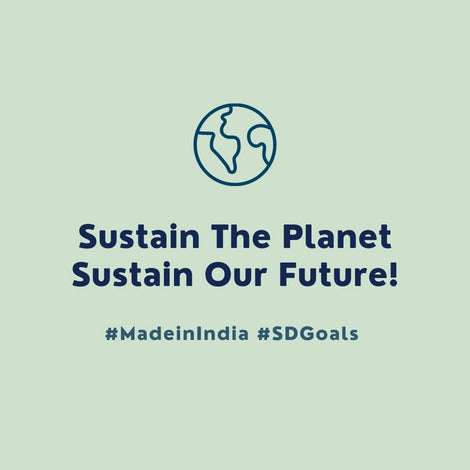What is Upcycling?

You might already be familiar with recycling, whether it be plastics or textiles but you might not be so aware of upcycling. The practice of upcycling has gained popularity in the sustainability community globally in the past decade. Multiple innovations and startups have come up in the upcycling industry. Upcycling is the process of turning materials that would have been discarded otherwise into something new, useful, and unique. The best part about upcycling is anything you make will always be one of its kind.
So, how does upcycling work? How does it benefit the environment? We're here to respond to all of your inquiries about upcycling. What Is Upcycling?
By definition, the term "upcycling" refers to recycling or reusing something in a way that raises the value of the original item. Upcycling is the process of taking something used and turning it into something new. Upcycling is a sustainable approach to waste reduction that involves converting discarded items into new products of equal or higher value. Unlike traditional recycling, which involves breaking down waste into raw materials that are then used to make new products, upcycling uses waste materials as they are, without any further processing. Upcycling is all about using creativity and innovation to create new, useful products from discarded items, and reducing the amount of waste sent to landfills in the process.
The main distinction between upcycling and downcycling is that upcycling involves creating a new, different product of high quality, while downcycling or recycling involves producing a lower-quality version of the same thing.
How Does Upcycling Help the Planet?
Upcycling has numerous benefits for the environment and is becoming an increasingly popular way for people to reduce their impact on the planet. Upcycling endorses a circular economy as well. Products are repeatedly used and reused in a circular economy as opposed to being thrown away after single use. This system is more environmentally friendly because it utilises what we already have as opposed to continuing to produce new products using new materials.
Some of the key ways in which upcycling helps the planet include:
● Minimizes the Extraction of Natural Resources- One of the biggest environmental benefits of upcycling is that it reduces the need for virgin materials, such as minerals, wood, and petroleum. By using waste materials to create new products, we can reduce the environmental impact of extracting and refining these raw materials, which often requires significant amounts of energy and results in greenhouse gas emissions.
● Reduces Landfill Waste- Another major benefit of upcycling is that it helps to reduce the amount of waste sent to landfills. Landfills are a significant source of methane emissions, which are potent greenhouse gas, and can take hundreds of years to decompose. By using waste materials to create new products, we can reduce the amount of waste sent to landfills and prevent these materials from contributing to greenhouse gas emissions.
● Less Manufacturing, Fewer Carbon Emissions- Finally, upcycling can also result in fewer carbon emissions from manufacturing processes. Creating new products from waste materials often requires less energy than refining raw materials into new products, which can result in fewer greenhouse gas emissions. Additionally, upcycling can also reduce the energy required for transportation, as waste materials are often repurposed locally, rather than being transported long distances to be processed and manufactured into new products.
How Can You Upcycle? You probably already have a tonne of items lying around your house that can be reused and repurposed, making upcycling at home simpler than you might imagine. You essentially use something that already exists for a different purpose. For instance, you could add fairy lights to old glass bottles to transform them into vases or table lamps. There are many ways that you can get involved with upcycling and make a positive impact on the environment.
Here are a few simple upcycling ideas that you can try at home:
● Reuse old clothing to create new clothing items, such as turning a t-shirt into a shopping bag.
● Repurpose glass bottles into vases or candle holders.
● Transforming old furniture into something new, such as an end table made from an old suitcase.
● Create a planter from an old tire or metal drum.
● Use old CDs or DVDs to create coasters or sun catchers
● Turn an old ladder into a bookshelf or plant stand
● Make your own mason jar candle lanterns for outdoor gatherings, baby and bridal showers, weddings, receptions, and more!
● This DIY project is so simple that you could complete it in less than an hour. All the corks should be gathered into the desired size for the coaster.
● In most cases, a coffee mug's broken handle can be fixed, but if it's truly beyond repair, your mug can join hordes of its pals around the globe as a windowsill planter.
● Have some plain flower pots you'd like to make more interesting? A simple way to add a tonne of colour is with mosaics!
● Make a useful candle holder out of broken plate pieces to use on your back deck for evening entertainment.
● Used Plastic spoons can be broken up and placed on a cardboard wreath form that you can purchase from a craft supply shop. Put a mirror in the centre and paint them in a colour you like.
● Make baskets out of used denim for both decorative and functional uses; fill the baskets with items to keep your home organised.
The bottom line:
Upcycling is a fun, creative, and environmentally friendly way to reduce waste and conserve natural resources. With a little bit of creativity and effort, anyone can upcycle waste materials into new, useful products. Whether you're looking to reduce your carbon footprint, conserve resources, or simply have fun with a new hobby, upcycling is a great way to make a positive impact on the planet.


